 |
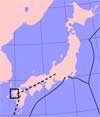 |
Estimation
of the thermal state of NW Kyushu mantle using primitive
basalts |
|
Hidehisa
Mashima
Tono Geoscience Center, Japan Nuclear
Cycle Development Institute, Jorin-ji 9598-31, Izumi-cho,
Toki-shi, Gifu, 509-5102, Japan
mashima.hidehisa@jnc.go.jp
|
 Click here to
download a PDF version of this webpage Click here to
download a PDF version of this webpage
The critical aspect of the debate regarding whether
a mantle plume exists or not is temperature. If a plume
exists it should have temperature higher than convecting
upper mantle since it comes from deeper parts of the
mantle e.g., the 660-km discontinuity or the
core-mantle boundary. If intraplate basalts are formed
by mantle plumes, as many authors assume, primitive
basalts should have melting temperatures higher than
MORB and subduction zone basalts formed by shallow mantle
convection. The results of previous melting experiments
of peridotites and pyroxenites suggest that the compositions
of partial melts depend on temperature. Thus, the petrochemistry
of primitive intraplate basalts can tell us whether
their source is abnormally hot or not. My colleague
and I have estimated source temperatures of the northwest
Kyushu basalts, southwest Japan (Higo & Mashima,
2004; Mashima,
2005).
Northwest Kyushu is located in the
backarc region where the Philippine Sea plate subducts
beneath the Eurasian plate (Figure 1). Seismic observations
suggest that the subducting Philippine Sea plate does
not extend beneath the Eurasian plate (Figure 2).
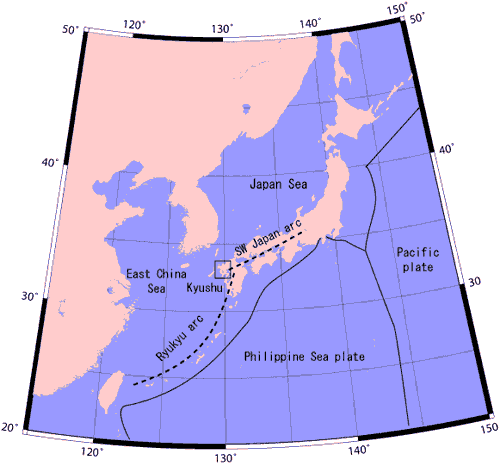
Figure 1: Map showing the tectonic
setting of NW Kyushu. NW Kyushu is at the junction of
the SW Japan arc and the Ryukyu arc, and the junction
of the Japan Sea and the East China Sea.
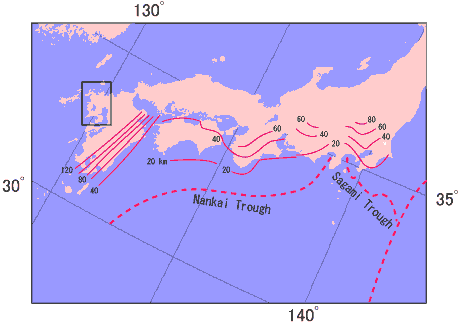
Figure 2: Map showing depth of the
subducting Philippine Sea plate (after Yamazaki &
Ooida, 1985; Ishida, 1992). The subducting Philippine
Sea plate does not extend beneath NW Kyushu.
NW Kyushu is also the junction of the
southwest Japan arc and the Ryukyu arc and of the Japan
Sea and the East China Sea. Mantle plumes are generally
believed to come from a thermal boundary at the 660-km
discontinuity or the core-mantle boundary. Tomographic
images, however, suggest that subducted Pacific plate
stagnates at the 660-km discontinuity beneath NE Asia
(Fukao et al., 1992), which means that the
660-km discontinuity beneath NW Kyushu is cold. Normal
faults in NW Kyushu (Figure 3) suggest that the stress
field there is essentially tensional. Volcanism in NW
Kyushu is characterized by the eruption of basaltic
lava flows since 10 Ma. Prior to this basaltic volcanism,
formation of inner arc sedimentary basins and their
uplift occurred. Because of petrochemical similarities,
Nakamura et al. (1985) suggested that NW Kyushu
volcanism is caused by plumes from the deep mantle.
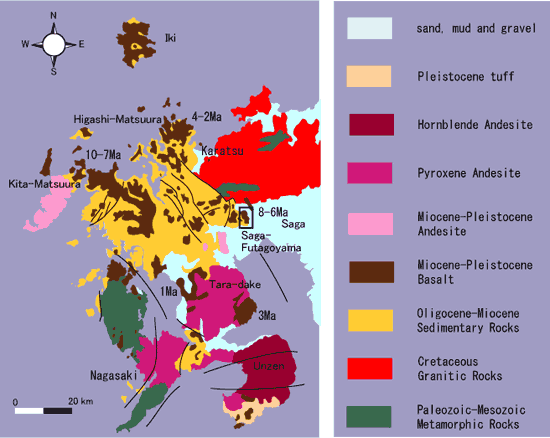
Figure 3: Simplified geological
map of NW Kyushu. Basalts erupted at 10-1 Ma are distributed
in NW Kyushu.
We
estimated melting temperatures of primitive NW
Kyushu basalts by comparison with the results
of high-pressure melting experiments of peridotites.
First, we selected primitive NW Kyushu basalts
using bulk rock Mg-Fe-Ni relationships (Figure
4). We calculated olivine compositions in equilibrium
with bulk rock compositions of analyzed samples
(details of the methods of calculation are given
in Higo & Mashima, 2004). Some of
calculated olivines have Mg-Fe-Ni compositions
similar to mantle olivines (Takahashi,
1986; Arai et al., 2001), which means
that the samples used for those calculations could
have been equilibrated with the mantle. Selected
samples show a negative Al2O3
– MgO correlation and a positive CaO –
MgO correlation similar to those observed in melting
experiments (Figure 5). This suggests that our
estimation of primitive melts is reasonable.
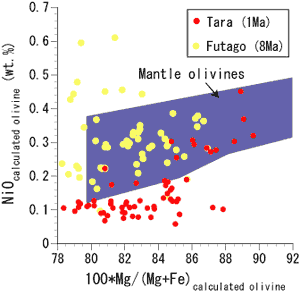
Figure 4: Mg-Fe-Ni
relationships of calculated olivines in equilibrium
with NW Kyushu basalts. Detailed methods of calculation
are given in Higo & Mashima (2004). Compositions
of mantle olivines were obtained from Takahashi
(1986) and Arai et al. (2001).
|
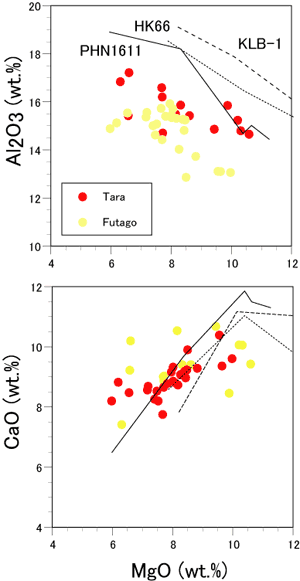
Figure 5: Relationships
between Al2O3, CaO and MgO. Results of melting
experiments were obtained from Hirose &
Kushiro (1993) [samples KLB1 and HK66] and Kushiro
(1996) [sample PHN1611].
|
Second, the pressure at which primitive
basalts were last in equilibrium with the mantle is
also estimated since the compositions of partial melts
in melting experiments also depend on pressure. Primitive
samples are plotted on a cotectic line at 1 GPa (Figure
6), which is consistent with the average depth of the
Moho beneath NW Kyushu (Murakoshi, 2003).
Finally, the melting temperatures of
the primitive basalts were estimated using the temperature-MgO
relation from previous melting experiments of peridotites.
The estimated melting temperature range is 1200-1300°C
(Figure 7), which is similar to that of MORB (Hirose
& Kushiro, 1993) and subduction zone basalts
(Tatsumi et al., 1983).
|
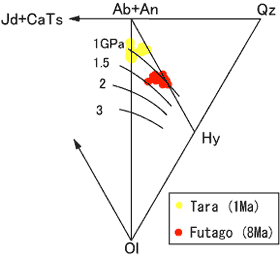
Figure 6: Normative
ol-qz-Jd+CaTs diagram. Cotectic lines were obtained
from Falloon & Green (1988). |
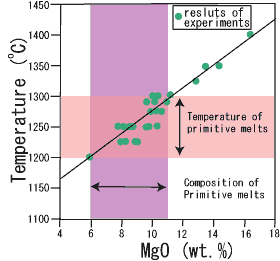
Figure 7: Relationship
between temperature and MgO in melts. The results
of melting experiments of peridotites at 1 GPa
were obtained from Takahashi & Kushiro (1983),
Hirose & Kushiro (1993) and Kushiro (1996).
|
Thus, the petrochemistry of primitive
NW Kyushu basalts suggests that they were formed by
upwelling of shallow mantle, as is the case for MORB
and subduction zone basalts. Upwelling forming NW Kyushu
basalts is probably caused by mechanical interaction
of the Philippine Sea plate and the Eurasia plate since
Cenozoic SW Japan basalts are concentrated in NW Kyushu,
the junction of the southwest Japan arc and the Ryukyu
arc, and of the Japan Sea and the East China Sea.
|
References
-
Arai S., Abe
N., Hirai H. and Shimizu Y. (2001) Geological, petrographical
and petrological characteristics of ultramafic-mafic
xenoliths in Kurose and Takashima, northern Kyushu,
southwestern Japan. Sci. Report, Kanazawa Univ.,
46, 9-38.
-
Ishida, M.,
(1992) Geometry and relative motion of the Philippine
Sea plate and Pacific plate beneath the Kanto –
Tokai district, Japan, J. Geophys. Res.,
97, 489-515, 1992
-
Falloon, T.
J. and Green, D. H. (1988), Anhydrous partial melting
of peridotite from 8 to 35 kb and the petrogenesis
of MORB, J. Petrol., Special Lithosphere Issue,
379-414.
-
Fukao, Y.,
Obayashi, M., Inoue H., and Nenbai M. (1992), Subducting
slabs stagnant in the mantle transition zone, J.
Geophys. Res., 97, 4809-4822.
-
Higo T. and
Mashima H. (2004) Thermal state of northwest Kyushu
mantle suggested by the petrochemistry of the Tara-dake
basalts, Geophys. Res. Lett., 31,
L03604, doi:10.1029/2003GL018734.
-
Hirose, K.,
and Kawamoto T. (1995) Hydrous partial melting of
lherzolite at 1 GPa: The effect of H2O
on the genesis of basaltic magmas, Earth Planet.
Sci. Lett., 133, 73–463.
-
Hirose, K.,
and Kushiro I. (1993) Partial melting of dry peridotites
at high pressures: Determination of compositions
of melts segregated from peridotite using aggregates
of diamond, Earth Planet. Sci. Lett., 114,
477–489.
-
-
Murakoshi
T (2003) Seismic structure of the crust and
uppermost mantle beneath Kyushu as inferred from
receiver function analysis, Ph.D. thesis, 87
pp., Kyushu University
-
Nakamura,
E., Chappell I. H. and Sun S.-S. (1985) The influence
of subduction processes on the geochemistry of Japanese
alkaline basalts, Nature, 316,
55–58.
-
Takahashi,
E. (1986), Origin of basaltic magmas: Implication
from peridotite melting experiments and an olivine
fractionation model (in Japanese with English abstract),
Bull. Volcanol. Soc. Japan, 30,
S17– S40.
-
Takahashi,
E., and Kushiro, I. (1983), Melting of a dry peridotite
at high pressures and basalt magma genesis, Am.
Mineral., 68, 859– 879.
-
Tatsumi, Y.,
Sakuyama, M., Fukuyama, H., and Kushiro, I. (1983),
Generation of arc magmas and thermal structure of
the mantle wedge in subduction zones, J. Geophys.
Res., 88, 5815– 5825.
-
Ymazaki, F
and Ooida T. (1985) Configuration of subducted Philippine
sea plate beneath the Chubu district, central Japan,
Zishin, 38, 193-202.
|
last updated 13th
June, 2005 |
|
|
